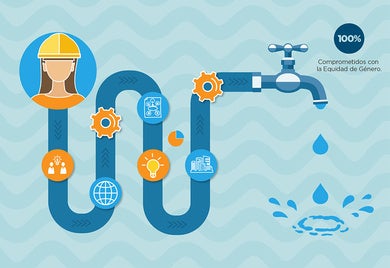
IDB World: Alleviating the Credit Crunch, Helping the Galapagos, Electrifying Transportation
We present three blog posts from the IDB Group on methods to alleviate the credit crisis among SMEs, helping the energy transition in the Galapagos Islands, and the electrification of transport.

Leveraging the Private Sector to Unlock the Caribbean’s Most Precious Resource
The Caribbean’s reliance on oceans, often the biggest avenue of transportation and the main source of local employment, presents a clear economic opportunity, particularly for the private sector.

Nudging People to Save Water through the Private Sector
World Water Day offers a chance to reflect on a vital resource that many of us take for granted: water. While changing people’s water consumption habits is not easy, strategies designed with human behavior in mind can help

Mobilizing the private sector to ensure access to water and sanitation for all
Sunday November 19th, 2017 will be Toilet Day. Why would we need a Toilet Day?! It is not a celebration day; as per the United Nations, “World Toilet Day is about taking action to reach the 2.4 billion people living without a toilet.” In Latin America and the Caribbean, access to sanitation is one of our greatest challenges: only 22% of the population has access to safely managed sanitation, and 20 million practice open defecation. So how do we make this day meaningful? We should put it in a wider context, as it obviously goes beyond raising awareness. Indeed, the Sustainable Development Goals (SDGs) propose to transform the world. Goal six ambitions to “ensure access to water and sanitation for all” includes a clear target: By 2030, achieve access to adequate and equitable sanitation and hygiene for all and end open defecation, paying special attention to the needs of women and girls and those in vulnerable situations. A $15 billion market There is a case for the private sector in this target: toilets play a crucial role in creating a strong economy, as well as improving health and protecting people’s safety and dignity. Given the magnitude of the resources needed and the public resources constraints, it is essential to mobilize the private sector for: the funding of the investments, the construction, and the efficiency improvement in the operation of the infrastructure. In sanitation, there are near 15 million households without access to improved sanitation in Latin America and the Caribbean, which represents a market and potential revenue of up to $15 billion only for construction of sanitation infrastructure. While in pit or septic tank emptying and wastewater/sludge collection services, the market potentially reached over a billion dollars per year across the region, according to an IDB study. This also means the potential creation of thousands of jobs, provided with the help of the private sector. A drop of financial innovation For this we need a clear risk-reward framework, recognizing that “financial sustainability can be achieved through a combination of rates, tariffs and subsidies”. Also, it is important to state that — under adequate models — the private sector can supplement the public-sector approaches to reach lower income population, which is the most affected by lack of service coverage. [clickToTweet tweet="In #sanitation, there is a potential revenue of up to $15 billion in #LatinAmerica & #Caribbean" quote="In sanitation, there is a potential revenue of up to $15 billion in Latin America and the Caribbean" theme="style1"] To better serve the base of the pyramid, the region needs to promote blend participation from public, private and financial sectors for water and sanitation services. For example, SOIL, in Haiti, shows an innovative sanitation business model for lower-income households. It is a service to collect the waste from ecological toilets to treatment plants, where it is sold for agricultural purposes. This sustainable model covers the entire sanitation chain and after a few years it has already served over 2,000 people. With only 12 years left to accomplish the SDGs and the vast amount of resources required, we should recognize the need for an integral approach to water and sanitation services. Today, those lacking these network services are those that pay the highest price for alternative arrangements. However, with coordination between the public and the private sector we could develop products to better serve them. Development banks, like the IDB Group, engaging the private sector through IDB Invest and leveraging its public-sector presence, have an important role to play in promoting those synergies. Subscribe to receive more content like this! [mc4wp_form]

Untapped Potential: Water, Women and Public-Private Partnerships
More than half century ago, John F. Kennedy said: “Anyone who can solve the problems of water will be worthy of two Nobel prizes — one for peace and one for science.” Today, despite having a third of the world’s freshwater resources, Latin America and the Caribbean is home to 30 million people without access to clean drinking water, and 100 million without safe sanitation. The impressive urban growth in the region during recent years has only exacerbated this problem. Women provide a unique perspective for water management The water availability challenge is already evident in the region — particularly within the poor communities in cities. Women and girls are the most affected in these households, as they are usually in charge of ensuring water provision for their families. For this reason, women can play a key role in the implementation of innovative solutions that are in-tune with the needs and preferences of impoverished communities. This can have a positive impact not only in less favored urban areas, but also in the overall way in which the sector currently operates. There are already cases where women have taken the lead in the management of poor communities’ water systems, and the results have been encouraging. This user-centered approach acknowledges women’s vital role in water provision, and is helpful not only in refining project design and management, but can also increase consumers’ willingness to pay for the service. For utility providers, this can translate into multiple benefits, including improved cash flows, more resources for infrastructure investments, and service quality enhancements. [clickToTweet tweet="Women make up less than 17% of the water and sanitation labor force #NegociosSostenibles" quote="Women make up less than 17% of the water and sanitation labor force" theme="style1"] Women’s participation in the sector does not only bring financial advantages. A Deloitte study shows that when men and women are equally involved in the design and operation of water systems, significant improvements in governance, transparency and sustainability are achieved. For example, in more than 120 water projects that included the participation of women during the design phase, the effectiveness was six to seven times higher than in projects which only included men. Yet, today women make up less than 17% of the water and sanitation labor force, and only a small fraction of management and technical experts. More needs to be done to reduce the gender gap in water provision services, and to ensure that more women have access to key roles — such as engineers, system designers and utility managers. Forging new partnerships in water One way to reduce this gender gap is by identifying partners that can catalyze the financial, technical and social advantages that the participation of women in water projects can bring – and the private sector is particularly well suited for the task. Additionally, promoting private investments in the sector can help tackle another important gap: the investment one. In 2012, only 0.2% of the region’s gross domestic product (GDP) was invested in water and sanitation, compared to 3% in overall infrastructure. Public-private partnerships (PPPs) have traditionally provided much-needed financing, technical know-how transfer and best practices in infrastructure management. While adopting PPP schemes is commonplace in energy and transportation projects, this has not been the case for water. In 2016, out of 96 PPP projects that reached financial closure in Latin America and the Caribbean, only seven were related to water and sanitation. Currently, the region’s public sector continues to hold the lion’s share of water and sanitation services. Nevertheless, many cities have adopted PPP models that work. Cartagena and Bogota contract services to mixed companies, jointly owned by local authorities, a private operator, and local private shareholders. The results have been impressive: between 1994 and 2002, access to clean water and sanitation improved significantly, and more than 80% of new connections were in poor neighborhoods. [clickToTweet tweet="Only 7 out of 96 PPP projects in #Latam and #Caribbean were for water and sanitation in 2016" quote="Only 7 out of 96 PPP projects in Latin America and the Caribbean were for water and sanitation in 2016" theme="style1"] Earlier this year, the Inter-American Development Bank (IDB) Group partnered with the Korean government and the Korea Eximbank to bring best practices in water management technology to Colombia. As part of a knowledge-sharing program, companies from both countries met in Bogota to better understand the operating conditions in that city and to discuss technology transfer plans. Among the conclusions of the meetings, both parts acknowledged the role that the private sector had in improving Bogota´s water operations. As urban demand for water rises across the region, leveraging the untapped potential of both public-private partnerships and women’s participation in water projects will be invaluable. Facilitating access to PPP solutions is one way to do it, like the new single window for PPPs launched earlier this year by the IDB Group. Another way is to have gender-inclusive perspectives at the core of the projects with women playing an active role in the development and implementation of sustainable projects, which is one of our commitments. By implementing this approach, our goal to promote solutions that effectively tackle the region’s water challenges. Subscribe to receive more content like this! [mc4wp_form]